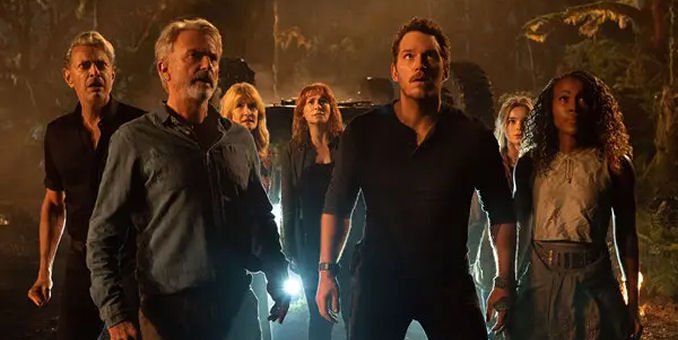
It has been four years since a volcanic eruption has destroyed the Jurassic World island theme park and the dinosaurs that were taken from heir have escaped into the wilds of the world. Owen (Chris Pratt) and Claire (Bryce Dallas Howard) have taken up residence in a cabin in the Sierra Nevada mountains in order to keep hidden Maisie (Isabella Sermon), the first and only human clone, from those who would wish to place her in a laboratory for study. However, they are discovered by poachers who capture Maisie and Beta, the offspring of Blue, the velociraptor that Owen trained years previously at the Jurassic World park.
Meanwhile, original Jurassic Park survivor Ellie Sattler (Laura Dern) is investigating a growing plague of giant locusts ravaging the midwest farmlands. Enlisting her longtime friend, and fellow Jurassic Park survivor, Alan Grant (Sam Neill), the two head for the Italian headquarters of the genetics research company BioSyn where they meet Ian Malcolm (Jeff Goldblum) who is helping them in their mission to to prove that the giant locusts are actually altered with dinosaur DNA by the company in order to corner the market on the world’s food supply chain. The trio run into Owen and Claire who have traced Maisie’s kidnappers to the same facility. The group soon discover that their separate paths have a common destination, but can they make it there while avoiding the dinosaurs in BioSyn’s dino wildlife preserve?
What is frustrating about Jurassic World: Diminion is that Trevorrow, who also co-wrote and directed the first installment of this Jurassic World trilogy and co-wrote the second part, has been building towards this idea that the knowledge to manipulate the basic building blocks of genetics could be a power as beneficial and as devastating as the ability to split the atom throughout this trilogy of films. And it is indeed an interesting idea to explore, given that genetic engineering is a fundamental part of the franchise’s premise.
But in following this storyline, Trevorrow seems to have forgotten the basic appeal of the Jurassic movies is dinosaurs on the loose, chasing screaming people. When he does remember to insert some dino/human action, the sequences are mounted with some verve, a car and motorcycle race through Malta with deadly raptors in pursuit particularly. But even then, there is often no real sense of danger. Previous movies remembered that they were at least part horror films and would introduce a number of supporting characters who could become potential dino chow as the story progressed. Trevorrow doesn’t do that here and the action is all the less for it because we never feel like anyone with a speaking line is in any danger.
On the other hand, what is fun is whenever Trevorrow gets his Jurassic World cast together with the classic Jurassic Park cast of Neill, Dern and Goldblum. There is a fun interaction there given their characters’ differing experiences and one finds themselves wishing to watch them all in a better movie, or even just sitting around and chatting for two hours over pizza and beer.





